Li S.Z., Jain A.K. (eds.) Encyclopedia of Biometrics
Подождите немного. Документ загружается.


generative statistical framework and follows the
▶ Bayesian Hypothesis Test representation.
This hypothesis test involves the estimation of
two probabilities: (H0), Y comes from the hypothe-
sized speaker S and (H1), Y is not from the hypo-
thesized speaker S , where Y is the observed speech
segment and S the targeted speaker. In GMM-UBM
approach, the models are Gaussian Mixture Models
which estimate a probability density function by:
pðxjlÞ¼S
M
i¼1
w
i
Nðxjm
i
; S
i
Þð1Þ
where w
i
, m
i
and S
i
are weights, means and covariances
associated with the Gaussian components in the mix-
ture. Usually a large number of components in the
mixture and diagonal covariance matrices are used.
The model l
hyp
is denoted world model or Univer-
sal Background Model (UB M) when the model is
environment independent. Its parameters are esti-
mated using the EM algorithm, maximizing the Maxi-
mum Likelihood criterion. The speaker model l
hyp
parameters are generally obtained by adapting the
world model parameters, using the Bayesian adapta-
tion framework. Generally, only mean parameters are
adapted and the other parameters remain unchanged
[5]. The MAP adaptation procedure follows the
formula:
m
i
map
¼
n
i
n
i
þ r
:m
i
emp
þð1
n
i
n
i
þ r
Þ:m
i
ubm
ð2Þ
where m
i
map
is the adapted mean for a given Gaussian
component i, m
i
emp
is the corresponding empirical
mean (obtained using the speaker enrollment data
and EM algorithm), m
i
ubm
is the corresponding UBM
mean, n
i
is the occupancy value for the component
(obtained also thanks to the EM algorithm, using
the UBM and the enrollment data) and r is a regula-
tion factor.
Speaker detection test relies on a log-likelihood
ratio computation. Regarding the large size of the
GMM models usually used (between 512 and 2,048
Gaussian components), a fast scoring technique is
usually used. This technique consists in computing
the ratio only on the n winning components, i.e. for a
given frame only the n highest component likelihoods
are computed for each target, the UBM model is used to
find this top-component set. If W is the world model, f
s
the test segment and L the hypothetic target model, the
test is computed as follows (usually, n ¼ 10):
lðf
s
jLÞ¼
X
n
i¼1
lðf
s
jy
L
i
Þþ
X
G
i¼nþ1
lðf
s
jy
W
i
Þð3Þ
where L and W are GMMs of G gaussian components,
each one of them respectively described by y
i
L
and y
i
W
.
(y being the parameters of a gaussian in a mixture:
y
i
¼ (m
i
, s
i
, a
i
) with i2[1,G]). It is important to
emphasize the multiple roles of the background
model, the UBM. This model is used to represent the
acoustic/phonetic/linguistic space. It is derived in order
to obtain the speaker models (and only the mean para-
meters are adapted for these speaker models). The UBM
model also drives the component selection during the
testing phase (fast computation technique). Finally, in
the decision step, the UBM represents the inverse hy-
pothesis (H1:Y is not from the hypothesized speaker S).
The UBM is clearly one of the key part of a GMM-
UBM speaker recognition system.
GMM Supervector Linear Kernel (GSL)
The SVM approach offers an alternative classification
strategy to the widely used GMM and has been inves-
tigated by many in the context of ASV, see for example
[6, 7].
Recalling that ASV is a two-class problem then all
expansion vectors corresponding to a given speaker in
the training mode are labeled for exampleþ1 and are
confronted individually by expansions from a cohort
of other speakers (loosely termed the impostor cohort)
with the label1. The result of the training is the
definition of a separating hyperplane:
f ðxÞ¼
X
N
SV
i¼1
a
i
t
i
R
1=2
FðX
i
Þx þ d ð4Þ
based on N
SV
support vectors and where t
i
represent
the ideal output,
P
N
SV
i¼1
a
i
t
i
¼ 0, d is an offset and R
1
is a diagonal normalization matrix. Then the classifier
model can be compacted as
w
X
¼
X
N
SV
i¼1
a
i
t
i
R
1
FðX
i
Þ
d
2
6
4
3
7
5
ð5Þ
enabling the evaluation of f(x) with a simple dot prod-
uct. Indeed, in the testing phase, the expansion of
the test segment is augmented by the value 1 and
1260
S
Speaker Matching

then a dot product between the two vectors of dimen-
sion Eþ1 is perf ormed to produce a verification score:
Score
SVM
ðX; Y Þ¼f ðR
1=2
FðY ÞÞ ¼ ½FðY Þ
t
1w
X
: ð6Þ
Because R
1∕2
is already integrated in w
X
, it is not
required in the calculation of f(R
1∕2
F(Y )).
The main difficult y for SVM based speaker-
recognition is to obtain a fixed length input vector
from a length-variable sequence of features. Several
solutions were investigated, like the GLDS method
proposed in [7]. Using the development of metrics in
GMM space [8, 9] proposed to use the UBM-GMM
system in order to extract the SVM input data. This
solution combines the best of the two approaches: it
takes adv antage of the statistical modeling power of
the GMM/generative approach and of the discrimina-
tive abilities of the SVM, w hich works only at the
decision level. this approach is denoted GMM Super-
vector Linear Kernel (GSL) in this chapter. The SVM
input vectors are gathered from the UBM-GMM para-
meters as defined bellow:
F
GSL
ðXÞ¼m
X
¼
m
1
X
:::
m
i
X
:::
m
C
X
2
6
6
6
6
4
3
7
7
7
7
5
; ð7Þ
It corresponds to the supervector comprising the
values of means, m
X
i
, taken from the GMMs, trained
on utterance X. Each GMM has C components and,
with an acoustic feature vector of size F, this gives a
F
GSL
(X) of size CF. The weight and variance para-
meters from the UBM are used to define r with
r
1
2
GSL
¼
ffiffiffiffiffi
l
1
p
S
1
2
1
:::
ffiffiffiffi
l
i
p
S
1
2
i
:::
ffiffiffiffiffiffi
l
C
p
S
1
2
C
2
6
6
6
6
4
3
7
7
7
7
5
ð8Þ
In terms of performance, the supervector approach
like GSL is close to the GMM-UBM approach when
a session mismatch technique is applied. Moreov er,
it allows to exploit other sources of information, like the
information gathered from the GMM weights in [10].
Hidden Markov Model (HMM)
A Hidden Markov Model (HMM) is a double sto-
chastic process in that it has an underlying stochastic
process that is not observable (hence the term hidden)
but can be observed through another stochastic pro-
cess that produces a sequence of observations [11].
A Markov chain consists of states and arcs between
these states. The arcs, which are associated to transit-
ion probabilities, permit to pass from one state to the
another, to skip a state, or contrary to remain in a state.
In a Hidden Markov Model, the real states sequence
is hidden but the state sequence that minimize the
probability of the observations given the HMM para-
meters could be easily determined using external
observations, such as the vectors resulting from the
pre-processing phase. The Hmms are more often
used in text-dependent speaker recognition tasks,
where there is a prior knowledge of the textual content.
The Hmms have a theoretical advantage on the GMM,
as Hmms can better model temporal variations [12,
13]. They also control the linguistic nature of the test
speech segment, adding a kind of password-based
security to the voice biometric identity verification.
HMM-based methods have been shown to outper-
form conventional methods in text-dependent speaker
verification [14].
Session Effects on Speaker Matching
The mismatch between the enrolment speech recording
and the test speech recording is one of the main problem
adressed in speaker recognition. Several factors compose
this mismatch: the recording environment (room acous-
tic, other people, cars, TV, etc.), the microphone, the
signal transmission channel, the phonetic or linguistic
content of the messages, the pathological aspects of the
speaker or the voice aging (for a given person, the voice is
changing along the life).
Dealing correctly with the session mismatch prob-
lem is mandatory in order to obtain a robust speaker
recognition system. The chapter Session effects on
speaker modelling is dedicated to this subject.
Related Entries
▶ Gaussian Mixture Model
▶ Hidden Markov model
▶ Speaker Features
▶ Universal Background Model
Speaker Matching
S
1261
S

References
1. Sakoe, H., Chiba, S.: Dynamic programming algorithm optimi-
zation for spoken word recognition. IEEE T. Acoust. Speech
(ASSP-26) 26(1), 43–49 (1978)
2. Booth, I., Barlow, M., Watson, B.: Enhancements to dtw and vq
decision algorithms for speaker recognition 13(3–4), 427–433
(1993)
3. Soong, F.K., Rosenberg, A.E., Rabiner, L.R., Juang, B.H.: A
vector quantization approach to speaker recognition. Approach
Speaker Recogn., 66(2), 14–26 (1987)
4. Bimbot, F., Bonastre, J.F., Fredouille, C., Gravier, G., Magrin-
Chagnolleau, I., Meignier, S., Merlin, T., Ortega-Garcia, J.,
Petrovska, D., Reynolds, D.A.: A tutorial on text-independent
speaker verification. EURASIP Journal on Applied Signal
Processing, Special issue on biometric signal processing (2004)
5. Reynolds, D.A., Quatieri, T.F., Dunn, R.B.: Speaker verification
using adapted Gaussian mixture models. Digit. Signal Process,
10(1–3), 19–41 (2000)
6. Wan, V.: Speaker Verification Using Support Vector Machines.
Ph.D. thesis, University of Sheffield (2003)
7. Campbell, W., Campbell, J., Reynolds, D., Singer, E., Torres-
Carrasquillo, P.: Support vector machines for speaker and language
recognition. Comput. Speech Lang., 20(2–3), 210–229 (2006)
8. Ben, M., Betser, M., Bimbot, F., Gravier, G.: Speaker diarization
using bottom-up clustering based on a parameter-derived dis-
tance between adapted gmms. In: ICSLP (2004)
9. Campbell, W.M., Sturim, D., Reynolds, D.A.: Support vector
machines using GMM supervectors for speaker verification.
IEEE Signal Process. Lett. 13 (2006)
10. Scheffer, N., Bonastre, J.F.: A UBM-GMM driven discriminative
approach for speaker verification. In: Odyssey (2006)
11. Rabiner, L., Juang, B.: Fundamentals of Speech Recognition.
Prentice-Hall, Upper Saddle River, (1992)
12. Nordstrm, T., Melin, H., Lindberg, J.: comparative study of
speaker verification systems using the polycost database.
In: International Conference on Spoken Language Processing
ICSLP (1992)
13. Tishby, N.: On the application of mixture ar hidden markov
models to text-independent speaker recognition. pp. 563–570
(1991)
14. Reynolds, D., Carlson. B.: Text-dependent speaker verification
using decoupled and integrated speaker and speech recognizers.
In: EUROSPEECH in Madrid, ESCA (1995)
Speaker Model
Speaker model is a representation of the identity of a
speaker obtained from a speech utterance of known
origin. It can be generative or discriminative. Most
popular generative speaker models are the Gaussian
Mixture Models (GMM), which model the statistical
distribution of speaker features with a mixture of
Gaussians. Typical discriminative speaker models are
based on the use of Support Vector Machines (SVM),
where the speaker model is basically a separating hy-
perplane in a high-dimensional space. Once enrolled,
speaker models may be compared to a set of features
coming from an utterance of unknown origin, to give a
similarity score.
▶ Speaker Features
Speaker Parameters
▶ Speaker Features
Speaker Recognition Engine
▶ Speaker Matching
Speaker Recognition, One to One
▶ Liveness Assurance in Voice Authentication
Speaker Recognition, Overview
JEAN HENNEBERT
Department of Informatics, University of Fribourg,
Fribourg, Switzerland
Institute of Business Information Systems HES-SO
Valais, TechnoArk, Sierre, Switzerland
Synonyms
Voice recognition; Voice biometric
1262
S
Speaker Model
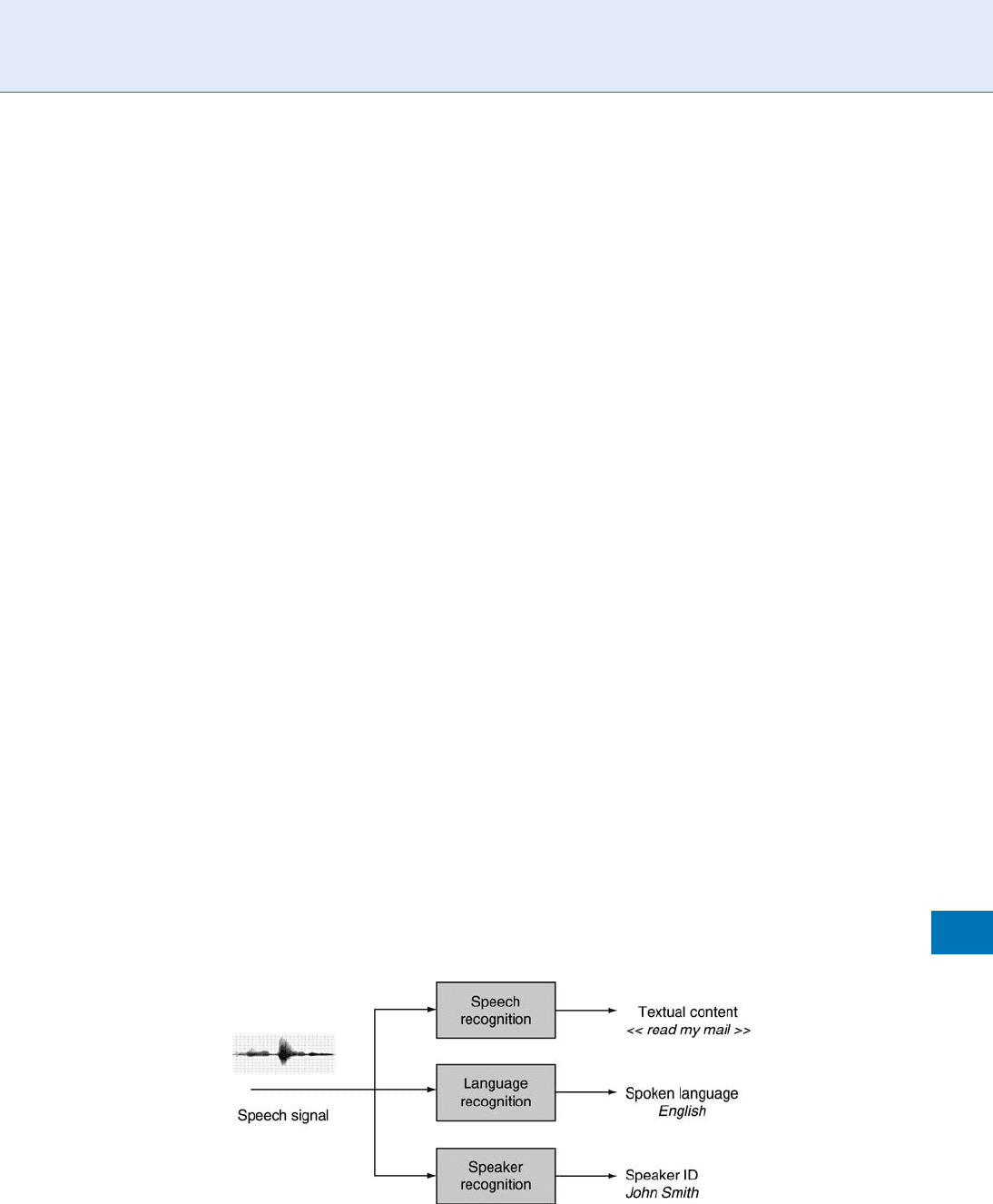
Definition
Speaker recognition is the task of recognizing people
from their voices. Speaker recognition is based on the
extraction and modeling of acoustic features of speech
that can differentiate individuals. These features conveys
two kinds of biometric information: physiological prop-
erties (anatomical configuration of the vocal apparatus)
and behavioral traits (speaking style). Automatic speak-
er recognition technology declines into four major
tasks, speaker identification, speaker verification, speaker
segmentation, and speaker tracking. While these tasks
are quite different for their potential applications, the
underlying technologies are yet closely related.
Introduction
Speaking is the most natural mean of communication
between humans. Driven by a great deal of potential
applications in human-machine interaction , auto-
mated systems have been developed to automatically
extract the different pieces of information conveyed in
the speech signal (Fig. 1). Speech recognition systems
attempt to transcribe the content of what is spoken.
Language identification systems aim at discovering the
language in use. Speaker recognition systems aim to
discover information about the identity of the speaker.
Interestingly, speaker recognition is one of the few
biometric approach which is not based on image proces-
sing. Speaker dependent features are actually indir ectly
measured from the speech signal which is 1-dimensional
and temporal. Speaker recognition is a biometrics quali-
fied as performance-based or active since the user has to
cooperate to produce a sequence of sou nds. This is also
a major difference with other passive biometrics such
as for fingerprints, iris, or face recognition systems
where user cooperation is not requested.
Speaker recognition technologies are often ranked
as less accurate than other biometric technologies such
as fingerprint or iris scan. However, there are two main
factors that make voice a compelling biometric. First,
there is a proliferation of automated telephony services
for which speaker recognition can be directly applied.
Telephone handsets are indeed available basically
everywhere and provide the required sensors for the
speech signal. Second, talking is a very natural gesture
and it is often considered as lowly intrusive by users as
no physical contact is requested. These two factors,
added to the recent scientific progresses, made speaker
recognition converge into a mature technology.
Speaker recognition finds applications in many dif-
ferent areas such as access control, transaction authen-
tication, forensics, speech data management, and
personalization. Commercial products offering voice
biometric are available from different vendors. How-
ever, many technical and non-technical issues, dis-
cussed in the next sections, still remain open and are
still subjects of in tense research.
History of Speaker Recognition
Research and development on speaker recognition
methods and techniques have now spanned more than
five decades and it continues to be an active area [1].
In 1941, the laboratories of Bell Telephone in New
Jersey produced a machine able to visualize spectro-
graph of voice signals. During the Second World War,
the work on the spectrograph was classified as a mili-
tar y project. Acoustic scientists used it to attempt to
Speaker Recognition, Overview. Figure 1 The different speech tasks can be declined into speech recognition, language
identification, and speaker recognition.
Speaker Recognition, Overview
S
1263
S

identify enemy voices from intercepted telephone and
radio communications. In the 1950’s and 1960’s, so-
called Experts testimony in forensic application started.
These experts were claiming that spectrographs were a
precise way to identify individuals, which is of course
not true in most conditions. They associated the term
‘‘voiceprint’’ to spectrographs, as a direct analogy to
fingerprint [2]. This expert ability to identify people on
the basis of spectrographs was very much disputed in
the field of forensic applications, for many years and
even until now [3].
The introduction of the first computers and mini-
computers in the 1960’s and 1970’s triggered the be-
ginning of more thorough and applied research in
speaker recognition [4]. More realistic access control
applications were studied incorporating real-life con-
straints as the need to build systems with single-session
enrolment. In the 1980’s, speaker verification began to
be applied in the telecom area. Other application issues
were then uncovered, such as unwanted variabilities
due to microphone and channel. More complex statis-
tical modelling techniques were also introduced such
as the Hidden Markov Models [5]. In the 1990’s, com-
mon speaker verification databases were made avail-
able through the Linguistic Data Consortium (LDC).
This was a major step that triggered more intensive
collaborative research and common assessment. The
National Institute of Standards and Technology (NIST)
started to organize open evaluations of speaker verifi-
cation systems in 1997.
In the present decade, the recent advances in com-
puter performances and the proliferation of automated
system to access information and services pulled spe-
aker recognition systems out of the laboratories into
robust commercialized products. Currently, the tech-
nology remains expensive and deployment still needs
lots of customization according to the context of use.
From a research point of view, new trends are also
appearing. For example, the extraction of higher-level
information such as word usage or pronunciation is
studied more for applications and new systems are
attempting to combine speaker verification with
other modalities such as face [6, 7] or handwriting [8].
Speech Signal
Speech production is the result of the execution of
neuromuscular commands that expel air from the
lungs, causes vocal cords to vibrate, or to stay steady
and shape the tract through which the air is flowing out.
As illustrated in Fig. 2, the vocal apparatus includes
three cavities. The pharyngeal and buccal cavities form
the vocal tract. The nasal cavity form the nasal tract
that can be coupled to the vocal tract by a trap-door
mechanism at the back of the mouth cavity. The vocal
tract can be shaped in many different ways deter-
mined by the positions of the lips, tongue, jaw, and
soft palate.
The vocal cords are located in the larynx and, when
tensed, have the capacity to periodically open or close
the larynx to produce the so-called voiced sounds. The
air is hashed and pulsed in the vocal apparatus at
a given frequency called the pitch. The sound then
produced resonates according to the shapes of the
different cavities. When the vocal cords are not vibrat-
ing, the air can freely pass through the lar ynx and two
types of sounds are then possible: unvoiced sounds are
produced when the air becomes turbulent at a point of
constriction and transient plosive sounds are produced
when the pressure is accumulated and abruptly re-
leased at a point of total closure in the vocal tract.
Roughly, the speech signal is a sequence of sounds
that are produced by the different articulators chang-
ing positions over time [9]. The speech signal can then
be characterized by a time-varying frequency content.
Figure 3 shows an example of a voice sample. The
signal is said to be slowly time varying or quasi-
stationary because when examined over short time
windows (Fig. 3-b), its characteristics are fairly station-
ary (5100 msec) while over long periods (Fig. 3-a),
the signal is non-stationary (>200 msec), reflecting
the different speech sounds being spoken.
The speech signal conveys two kinds of information
about the speaker’s identity:
1. Physiological properties. The anatomical configura-
tion of the vocal apparatus impacts on the prod-
uction of the speech signal. Typically, dimensions
of the nasal, oral, and pharyngeal cavities and the
length of vocal cords influence the way phonemes
are produced. From an analysis of the speech signal,
Speaker recognition systems will indirectly capture
some of these physiological properties characteriz-
ing the speaker.
2. Behavioral traits. Due to their personality type and
parental influence, speakers produce speech with
different phonemes rate, prosody, and coarticulation
1264
S
Speaker Recognition, Overview
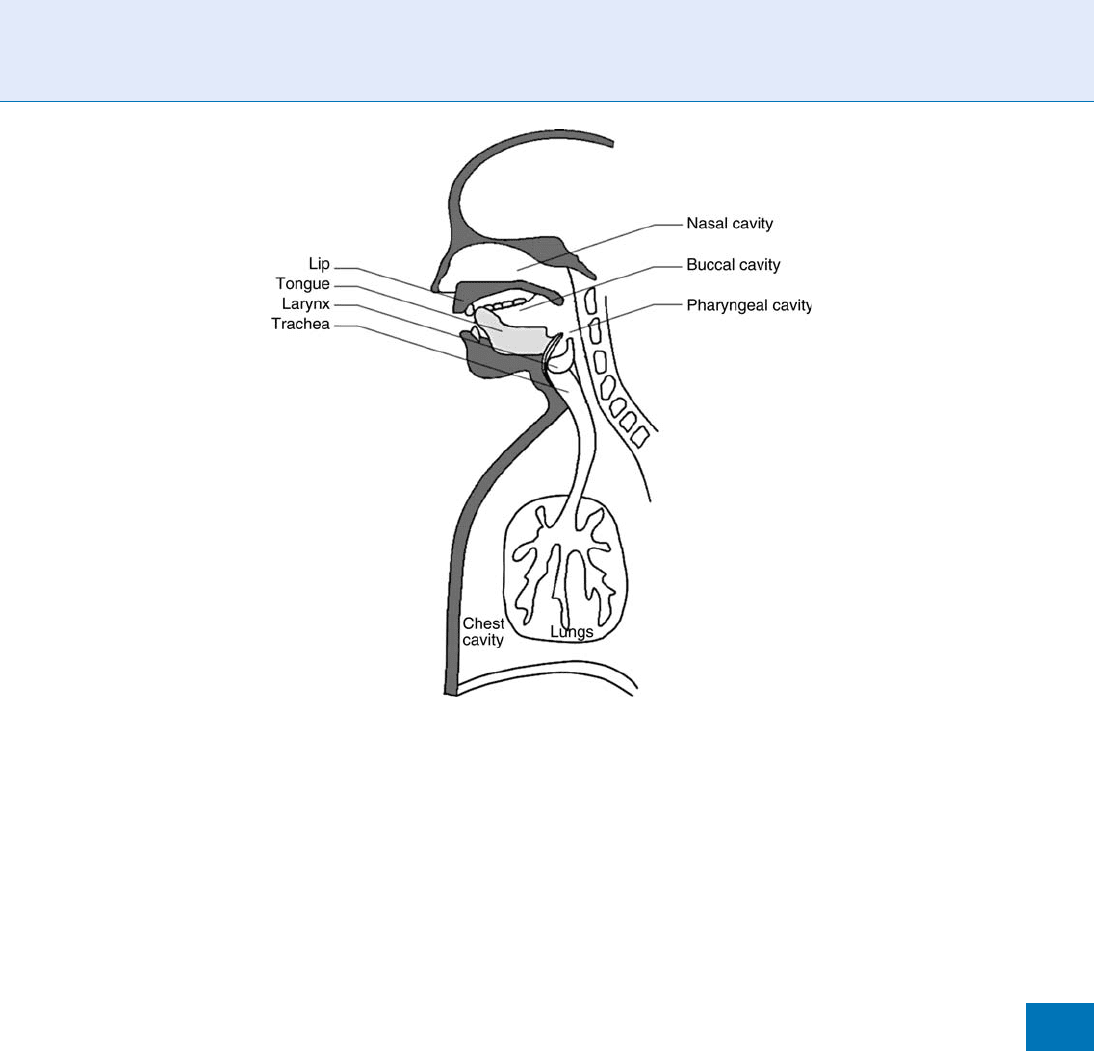
effects. Due to their education, socio-economic
status, and environment background, speakers use
different vocabulary, grammatical constructions,
and diction. All these higher-level traits are of
course specific to the speaker. Hesitation, filler
sounds, and idiosyncrasies also give perceptual
cues for speaker recognition.
Most of the speaker recognition systems are relying
on low-level acoustic features that are linked to the
physiological properties. Some behavioral traits such as
prosody or phoneme duration are partly captured by
some systems. Higher-level behavioral traits such as
preferred vocabulary are usually not implicitly modeled
by speaker recognition systems because they are difficult
to extract and model. Typically, the system would need a
large amount of enrolment data to determine the pre-
ferred vocabulary of a speaker, which is not reasonable
for most of the commercial applications.
Intra-speaker variabilities are due to differences of
the state of the spe aker (emoti onal, health, ...). Inter-
speaker variabilities are due to physiological or
behavioral differences between speakers. Automatic
speaker recognition systems exploit inter-speaker vari-
abilities to distinguish between speakers but are im-
paired by the intra-speaker variabilities which are, for
the voice modality, numerous.
Feature Extraction and Modeling
In the case of the speech signal, the feature extrac-
tor will first have to deal with the long-term non-
stationarit y. For this reason, the speech signal is usually
cut into frames of about 10-30 msec and feature ex-
traction is performed on each piece of the waveform.
Secondly, the feature extraction algorithm has to cope
with the short-term redundancy so that a reduced and
relevant acoustic information is extracte d. For this
purpose, the representation of the waveform is generally
swapped from the temporal domain to the frequency
domain, in which the short-term temporal periodicity
is represented by higher energy values at the frequency
Speaker Recognition, Overview. Figure 2 Schematic view of the human vocal apparatus. The vocal apparatus
includes three cavities: the pharyngeal, buccal, and nasal cavities. These cavities form the vocal and nasal tract that can
be shaped in many different ways determined by the positions of the lips, tongue, jaw, and soft palate.
Speaker Recognition, Overview
S
1265
S
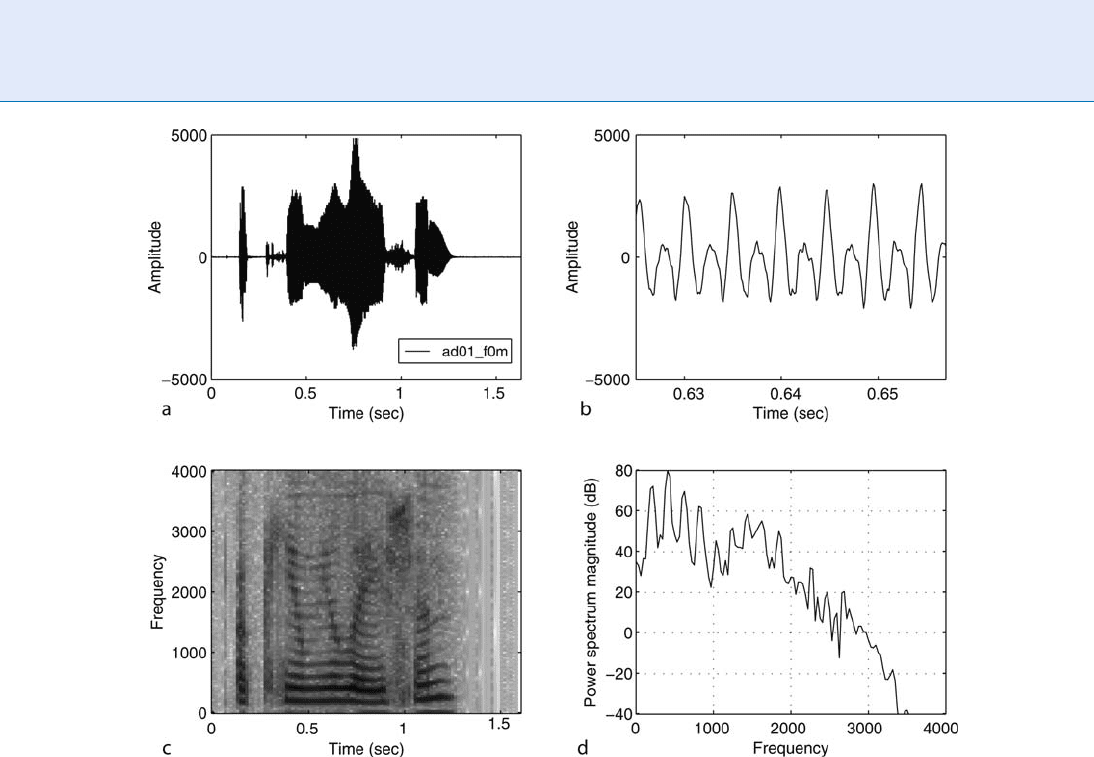
corresponding to the period. Thirdly, feature extrac-
tion should smooth out possible degradations incurred
by the signal when transmitted on the communication
channel. For example, in the case of telephone speech,
the limited bandwidth and the channel variability will
need some special treatment. Finally, feature extraction
should map the speech representation into a form
which is compatible with the statistical classification
tools in the remainder of the processing chain.
Usual feature extraction techniques are the so-
called linear predictive coding (LPC ) cepstral analysis
or the mel-frequency cepstral analysis. The se algorithms
are widely used in the field of speech processing [9, 10].
The output of the feature extraction module is a tem-
poral sequence of acoustic vectors X ¼ {x
1
, x
2
, ..., x
N
}
of length N with each vector x
n
having a constant
dimension D. The sequence X is then input into the
pattern classification module.
There are many different ways reported in the scien-
tific literature to build speaker models: vector
quantization, second order statistical methods, Gaussian
Mixtures Model (GMM), Artificial Neural Network
(ANN), Hidden Markov Model (HMM), Support
Vector Machines (SVM), etc. One of the most widely
used is GMM modeling. By nature, GMMs are versatile
as they can approximate any probability density function
given a sufficient number of mixtures. With GMMs, the
probability density function p(x
n
jM
client
)orlikelihood
of a D-dimensional feature vector x
n
given the model
of the client M
client
, is estimated as a weig hted sum of
multivariate gaussian densities (e.g., [11]).
Speaker Recognition Tasks and
Applications
Automatic speaker recognition can be declined into
four tasks (Fig. 4).
Speaker identification attempts to answer the ques-
tion ‘‘Whose voice is this?’’ In the case of large speaker
Speaker Recognition, Overview. Figure 3 Speech signal of the word accumulation:(a) waveform, (b) partial waveform,
(c) narrow-band spectrogram of (a), (d) power spectrum magnitude of (b).
1266
S
Speaker Recognition, Overview
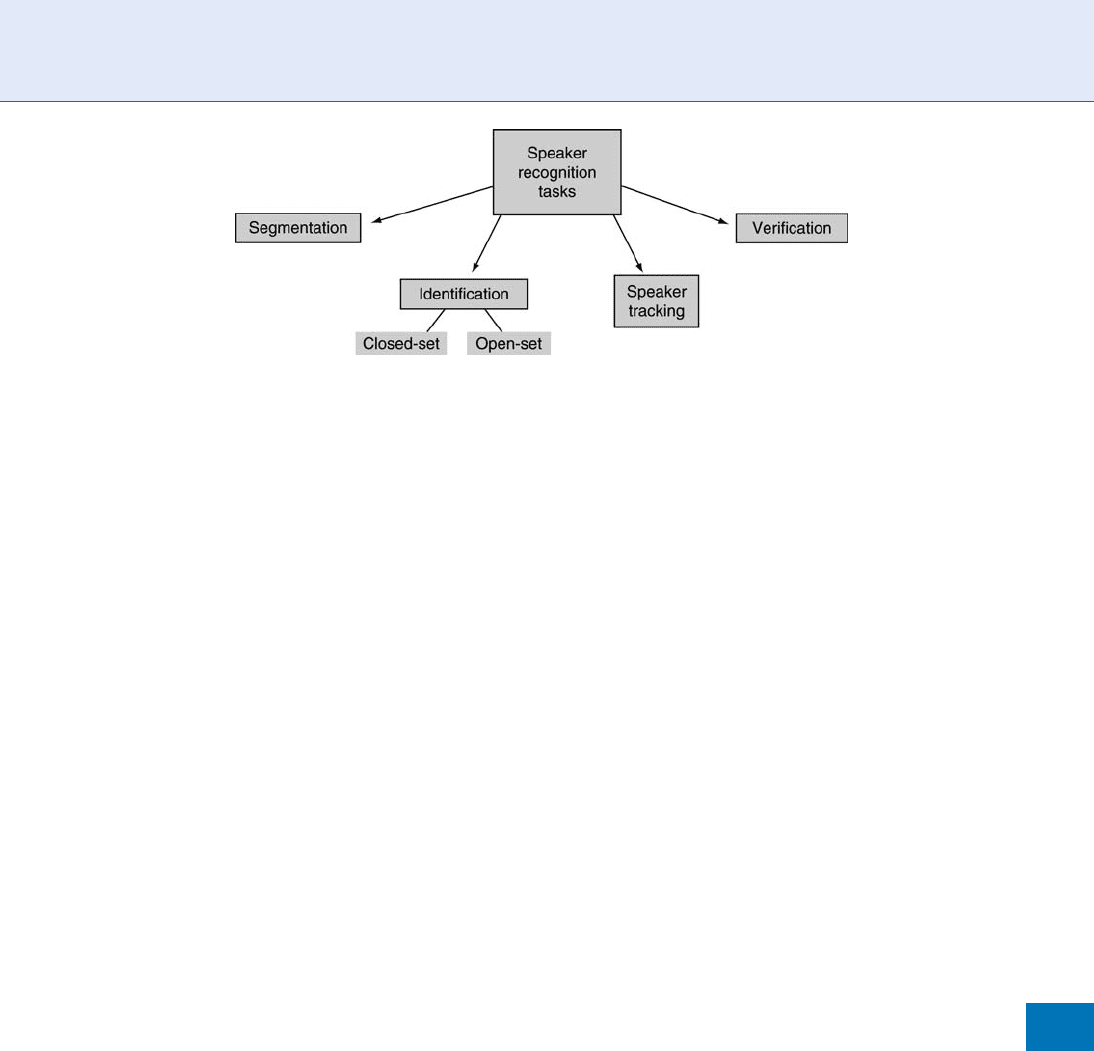
sets, it can be a difficult task where chances are more to
find speakers with similar voice characteristics. The
identification task is said to be closed-set if it is sure
that the unknown voice comes from the set of enrolled
speaker. By adding a ‘‘none-of-the-speaker’’ option,
the task becomes an open-set identifi cation. Speaker
identification is mainly applied in surveillance do-
mains and, apart from this, it has a rather small num-
ber of commercial applications. Speaker verification
(Also known as speaker detection or speaker authentica-
tion task.) attempts to answer the question ‘‘Is this the
voice of Mr Smith?’’ In other words, a candidate
speaker claims an identity and the system must accept
or reject this claim. Speaker verification has a lot of
potential commercial applications thanks to the grow-
ing number of automated telephony services. When
multiple speakers are involved, these tasks can be ex-
tended to speaker tracking (when a given user is
speaking) and speaker segmentation (blind clustering
of a multi-speaker record).
Speaker recognition systems can also be classified
accordingtothetypeoftextthattheuserutterstoget
authenticated. One can distinguish between
▶ text-
dependent,
▶ text-prompted, and ▶ text-independent
systems. These categories are generally used to classify
speaker verification tasks. To some extent, they can also
apply to the task of identification.
Text-dependent systems. These systems use the same
piece of text for the enrolment and for the sub-
sequent authentication sessions. Recognition per-
formances of text-dependent systems are usually
good. Indeed, as the same sequence of sounds is
produced from session to session, the charact-
eristics extracted from the speech signal are
more stable. Text-dependency also allows to use
finer modeling techniques capable to capture infor-
mation about sequence of sounds. A major draw-
back of text-dependent systems lies in the replay
attacks that can be performed easily with a simple
device playing back a pre-recorded voice sample of
the user. The term password-based is used to qualify
text-dependent systems where the piece of text is
kept short and is not supposed to be know n to
other users. There are system selected text/password
where an a priori fixed phrase is composed by the
system and associated to the user (e.g., pin codes)
and user selected text/password where the user can
freely decid e on the content of the text.
Text-prompted systems. Here the sequence of words
that need to be said is not known in advance by the
user. Instead, the system prompts the user to utter
a randomly chosen sequence of words. A text-
prompted system actually works in two steps.
First, the system performs spe ech recognition to
check that the user has actually said the expected
sequence of words. If the speech recognition
succeeds, then the verification takes place. This
challenge-response strategy achieves a good level of
security by preventing replay attacks.
Text-independent. In this case, there is no constraint
on the text spoken by the user. The advantages are
the same as for the text-prompted approach: no
password needs to be remembe red and the system
can incrementally ask for more data to reach a
given level of confidence. The main drawback lies
here in the vulnerability against replay attacks since
any recording of the user’s voice can be used to
break into the system.
Speaker Recognition, Overview. Figure 4 From left to right, the different speaker recognition tasks can be loosely
classified from the most difficult to the less difficult ones. The tasks of verification and identification are the major
ones considering the potential commercial applications.
Speaker Recognition, Overview
S
1267
S

Speaker recognition finds applications in many dif-
ferent areas such as telephony transaction authentica-
tion, access control, speech data management, and
forensics. It is in the telephony services that speaker
recognition finds the largest deal of applications as the
technolog y can be directly applied without the need to
install any sensors.
Telephony authentication for transactions. Speaker
recognition is the only biometric that can be directly
applied to the auto mated telephony ser v ices (In-
teractive Voice Response - IVR systems). Speaker
recognitiontechnologycanbeusedtosecurethe
access to reserved telephony services or t o authen-
ticate the user while doing automated transac-
tions. Banks and telecommunication companies
are the main potential clients for such systems.
As many factors impact on t he performances
of speaker recognition in telephony environ-
ment, it is o ften used as a complement to other
existing authentication procedures. Most of the
implementations are using a text-prompted pro-
ced ure to avoid pre-recording attacks an d to
facilitate the interaction with a dialog where the
user just needs to repeat what the system is
prompting. A less known but interesting example
of speaker verification application in telephony is
also the home incarceration and parole/probation
monitoring.
Access control. Speaker verification can be used
for physical access control in combination with
the usual mechanisms (key or badge) to improve
security at relatively low cost. Applications such
as voice-actuated door locks for home or igni-
tion switch for automobile are already com-
mercialized. Authorized activation of computers,
mobile phones, or PDA is also an area for poten-
tial applications. Such applications are often
based on text-dependent procedures using single
passwords.
Speech data management and personalization.
Speaker tracking can be used to organize the infor-
mation in audio documents by answering the ques-
tions: who and when a given speaker has been
talking? Typical target applications are in the
movie and media industry with speaker indexing
and automatic speaker change detection for auto-
matic subtitling . Automatic annotation of meeting
recordings and intelligent voice mail could also
benefit from this technology. In the area of perso-
nalization, applications to recognize broad speaker
characteristics such as gender or age can be used to
personalize advertisements or services.
Forensic speaker recognition. Some criminal cases
have recordings of lawbreakers voice and, speaker
verification technologies can help the investigator
in directing the investigation. On the other hand,
there is a general acceptation in the scientific com-
munity on the fact that a verification match
obtained with an aut omatic system or even with a
so-called voiceprint expert, should not be used as a
proof of guilt or innocence [3].
Performances and Influencing
Factors
Figure 5 summarizes typical ranges of Equal Error Rate
(EER) performances for four categories of speaker
verification systems [12]. The range of performances
is globally extremely large, going from 0.1 to 30%
across the systems. Text-dependent applications using
high quality speech signals can have very low EER
typically ranging from 0.1 to 2%. Such performances
are obtained with multi-session enrolment of several
minutes and test data of several seconds acquired in the
same condition as for the enrolment. Pin-based text-
dependent applications running on the telephony
channel will typically show performances ranging
from 2 to 5%. Text-independent applications based
on telephony quality, recorded during conversations
over multiple handsets and using several minutes of
multi-session enrolment data and a dozen of seconds
for the test data, will show EER ranging from 7 to 15%.
Finally, text-independent applications based on very
noisy radio data will show performa nces ranging
from 20 to 35%.
Summary
Speaker recognition is often ranked as providing me-
dium accuracy in comparison to other biometrics.
This is due to three main factors. First, there are the
inherent and numerous intra-speaker variabilities of
the speech signal (emotional state, health condition,
age). Second, the inter-speaker variabilities ar e
1268
S
Speaker Recognition, Overview
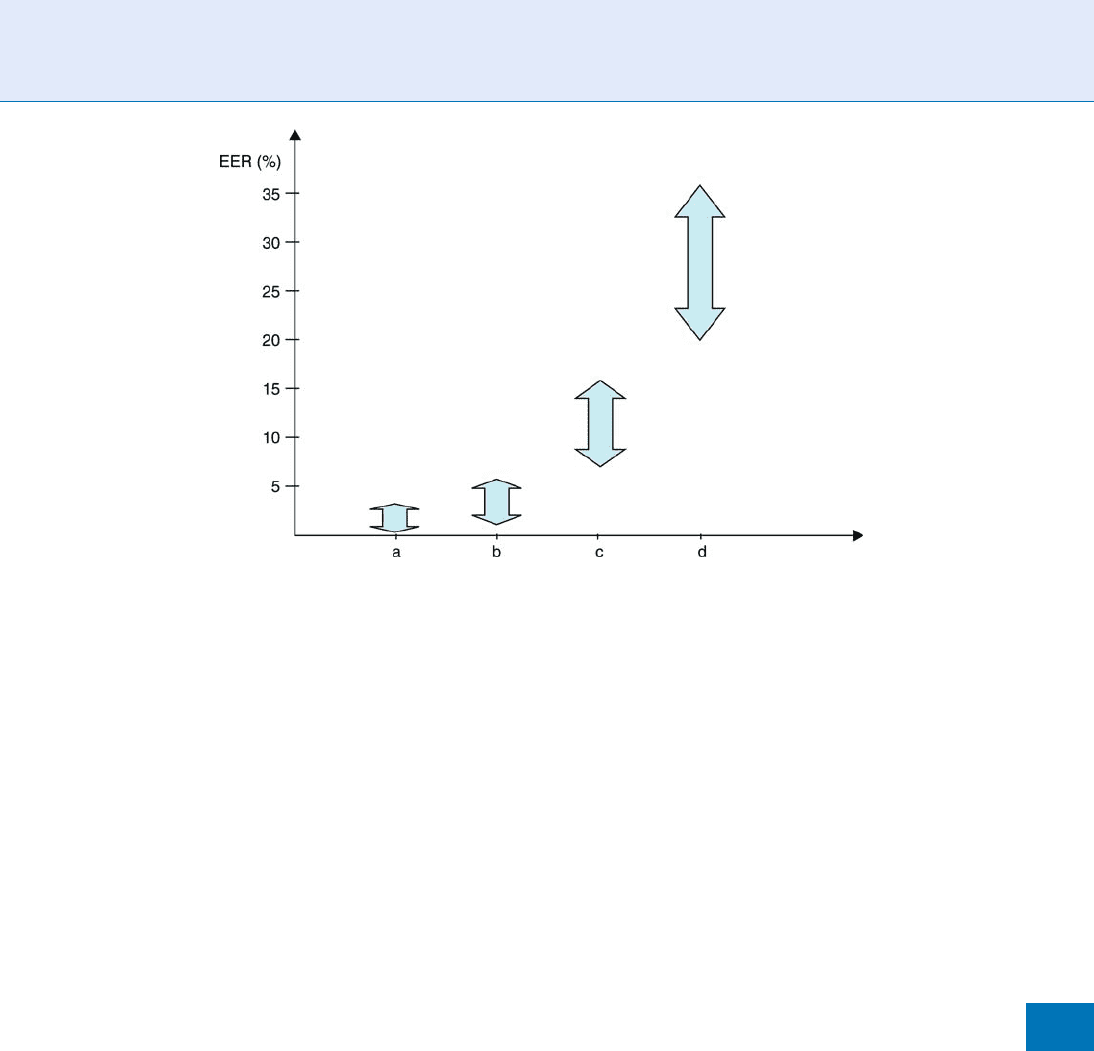
relatively weak, especially within family members.
Finally, the speech signal is often exposed to all sort of
envir onmental noise and distortions due to the commu-
nication channel. These varying acquisition conditions
are captur ed by the speech template which becomes
biased. To smooth out these variabilities, lengthy or
repeated enrollment sessions are often performed, but
this is generally at the expense of usability.
Speaker recognition remains however a compelling
biometrics. First, talking is considered a very natural
gesture and user acceptance is generally hig h. Further-
more no physical contact is requested to record the
biometric sample and the rate of failure to enroll is also
very low. Finally, the technology cost of ownership is
pretty low. For computer-based applications, simple
sound cards and microphones are available at low-
cost. For telephony applications, there is no need for
special acquisition devices as any handset can be used
from basically anywhere.
Speaker recognition technology has made tremen-
dous progress over the past 20 years and finds new
applications in many different areas such as telephony
authentication, access control, law enforcement,
speech data management, and personalization.
Related Entries
▶ Biometrics, Overview
▶ Speaker Feature
▶ Session Effects on Speaker Modeling
▶ Speech Analysis
▶ Speech Production
References
1. Furui, S.: 50 years of progress in speech and speaker recognition.
In: Proceedings of SPECOM, pp. 1–9 (2005)
2. Kersta, L.: Voiceprint Identification. Nature 196, 1253–1257
(1962)
3. Boe, L.J.: Forensic voice identification in France. Speech Com-
mun. 31, 205–224 (2000)
4. Atal, B.S.: Automatic recognition of speakers from their voices.
Proc. IEEE 64, 460–475 (1976)
5. Naik, J.M., Netsch, L.P., Doddington, G.R.: Speaker verification
over long distance telephone lines. In: Proceedings of the IEEE
International Conference on Acoustics, Speech and Signal Pro-
cessing, Glasgow, Scotland pp. 524–527 (1989)
6. Jain, A., Ross, A., Prebhakar, S.: An introduction to biometric
recognition. IEEE Transactions on Circuits and Systems for
Video Technology, Special Issue on Image- and Video-Based
Biometrics 14(1) (2004)
Speaker Recognition, Overview. Figure 5 Typical performances of speaker verification systems. The arrows define
ranges of Equal Error Rates for four different types of applications. Applications of type (a) are text-dependent based on
high quality speech signals. Applications of type (b) are text-dependent based on telephony speech quality, typically a
pin-based application. Applications of type (c) are text-independent on telephony speech quality recorded during
conversations. Applications of type (d) are text-independent based on very noisy radio.
Speaker Recognition, Overview
S
1269
S
